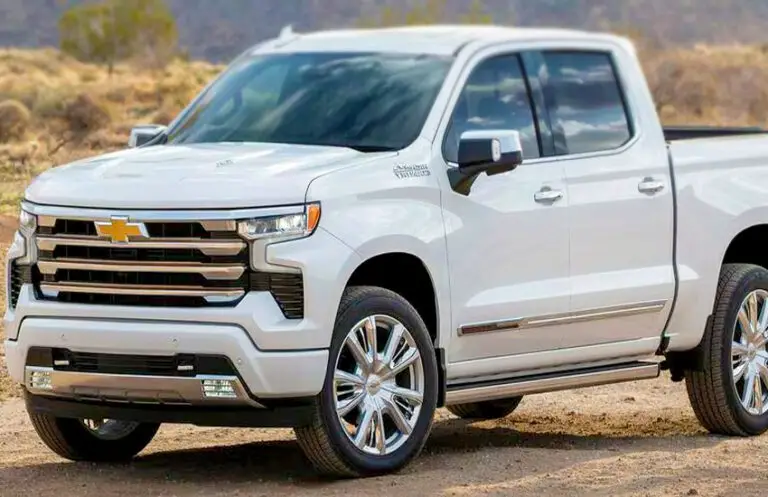As an Amazon Associate, I earn from qualifying purchases at no extra cost to you.
How to Replace a Rear Bumper on a Chevy Silverado: Easy Steps
Replacing a rear bumper on your Chevy Silverado can feel like a daunting task, but don't worry! With the right tools and guidance, you can tackle it yourself and save a ton of money. Whether your bumper is damaged or you’re just upgrading to a new one, this detailed guide will walk you through the entire process step-by-step. Ready to get started? Let's dive in!
Preparing Your Chevy Silverado for Rear Bumper Replacement
Before you begin removing the old bumper and installing a new one, it’s crucial to prepare your Chevy Silverado. Doing this will make the entire process smoother and ensure you're working in a safe environment. Let's go over what you need to do before diving into the actual bumper replacement.
Gather the Necessary Tools
The first step is to make sure you have all the tools you'll need. Having the right tools will make your job much easier and save you from any frustration. Here’s what you’ll need:
- Socket set (with various sizes, especially 10mm, 13mm, and 15mm)
- Ratchet wrench
- Screwdrivers (both flathead and Phillips)
- Pliers
- Torque wrench
- A jack and jack stands (for lifting the truck, if necessary)
- A friend or helper (this job is a lot easier with two people!)
Ensure Safety and Comfort
Before you start working, it's important to make sure you're in a safe and comfortable working environment. Park your Silverado on a flat, even surface to avoid any accidents. If you’re working in a garage or driveway, make sure it's well-lit. It's also a good idea to wear safety gloves to protect your hands from sharp edges and any debris. Safety is always the top priority!
You should also wear clothes that you don’t mind getting dirty. You'll be dealing with bolts, dirt, and maybe even some rust, so it's best to be prepared for that.
Disconnect the Vehicle's Battery
One of the key steps before working on anything electrical, like the bumper sensors or lights, is to disconnect the battery. This will prevent any electrical shocks or short circuits while you're working. Simply use a wrench to loosen the nut on the negative battery terminal and remove it. This step only takes a minute and can save you from potential problems.
Lift the Truck (If Necessary)
If you’re going to be removing heavy parts or dealing with tough angles, it's best to lift your Silverado slightly off the ground. Using a jack and jack stands, lift the rear end of your truck so you have easier access to the bumper. Be sure to follow proper lifting procedures, and never work under a vehicle without secure jack stands in place.
Step-by-Step Guide to Removing the Old Rear Bumper
Now that your truck is properly prepared, it's time to start the bumper removal process. This part might take a bit of time and patience, but it's not difficult once you know what to do.
Locate the Bumper Fasteners
Your Chevy Silverado's rear bumper is secured with a series of bolts and screws. These are usually located in several key areas, including under the truck, around the fender wells, and along the sides of the bumper. Start by locating all the fasteners that are holding the bumper in place.
Remove the Bumper's Lower Bolts
The lower bolts are typically the first ones you'll need to remove. Use your socket wrench to loosen and remove these bolts. If the bolts are rusted or stuck, you might need to apply some penetrating oil and let it sit for a few minutes to loosen them up. Once they’re free, carefully set them aside.
Remove the Upper Fasteners and Attachments
After removing the lower bolts, it's time to focus on the upper fasteners. Depending on your Silverado's model, the upper bolts might be located in different areas, such as inside the truck bed or under the bumper itself. Again, use your socket wrench to loosen and remove these. Be sure to keep track of the screws and bolts so you don't lose them!
If your Silverado has any electrical components attached to the bumper, like backup sensors or license plate lights, you'll need to carefully disconnect those as well. Use your screwdriver or pliers to disconnect any wiring or clips.
Detach the Bumper from the Mounting Brackets
Once all the bolts and fasteners are removed, the next step is to detach the bumper from the mounting brackets. These brackets are typically located on either side of the bumper and may require a little wiggling to get loose. With the help of a friend, gently pull the bumper off the truck. It may be heavy, so take care when lifting it.
Remove Any Additional Components
In some cases, the bumper may have additional components, such as tow hooks, trim pieces, or bumper pads. These will need to be removed as well. Use your pliers or screwdriver to take off any additional parts that are attached to the bumper. This will clear the way for installing your new one.
Installing the New Rear Bumper on Your Chevy Silverado
Now comes the fun part—installing the new rear bumper! This section will guide you through every step of the installation process to make sure everything fits perfectly.
Position the New Bumper in Place
With the old bumper removed, it's time to line up your new bumper. Make sure it's positioned correctly with the mounting brackets and any electrical components. It's often easier if you have a friend help you hold the bumper in place while you secure it. Be sure to align it properly so that everything lines up with the truck.
Secure the Bumper to the Mounting Brackets
Once the bumper is aligned correctly, begin securing it to the mounting brackets. Use the bolts and screws you removed earlier or the new ones that came with your replacement bumper. Tighten the bolts just enough to hold the bumper in place but don't fully tighten them yet. You'll want to adjust the bumper slightly if needed.
Reattach the Electrical Components
If your Silverado has sensors, lights, or any other electrical components on the rear bumper, now is the time to reconnect them. Carefully plug everything back in, ensuring that all the connectors are properly fitted. Double-check all wires and connections to make sure everything is secure and there's no risk of loose connections.
Tighten All Bolts and Screws
Once the bumper is properly aligned and all components are reconnected, go ahead and tighten the bolts and screws completely. Use a torque wrench to ensure that everything is tightened to the proper specification. This is an important step because you don't want the bumper to come loose while driving.
Reattach the License Plate and Trim
If you removed your license plate or any trim pieces during the removal process, now is the time to put them back on. Simply reattach the license plate bracket, ensuring it's level and securely fastened. If there are any trim pieces, use screws or clips to reattach them.
Tips for Ensuring a Properly Installed Rear Bumper
The installation might seem like it's done, but there are a few tips that can help ensure your bumper is properly installed and will last for years to come. These tips will help you double-check your work and make sure everything is in top condition.
Double-Check for Proper Alignment
Before you wrap up, step back and take a look at the bumper from different angles. Make sure it's properly aligned with the body of your truck and that it sits evenly on both sides. If it looks off-center, you might need to loosen the bolts slightly and adjust it again.
Inspect the Electrical Connections
Check all your electrical connections one more time. Sometimes wires can get pinched or disconnected during the process. Make sure that everything is securely plugged in and there are no loose connections, especially for sensors and lights.
Test the Backup Sensors and Lights
After installation, test out the backup sensors, lights, and any other electrical components that were connected to the bumper. This will ensure that everything is working as it should. If any of the sensors aren't working, double-check the wiring connections or replace the faulty part.
Tighten Bolts One Final Time
Once everything looks good, go over the bolts one last time to make sure they're all properly tightened. You can use your torque wrench to verify the tightness if you're unsure. This will help prevent any issues while you're driving.
Lower the Truck and Clean Up
If you raised your Silverado for easier access, now it's time to carefully lower it back to the ground. Once the truck is back in position, clean up your tools and any debris that might have accumulated during the process.
I hope this article helped you learn how to replace the rear bumper on your Chevy Silverado. By following these simple steps and tips, you'll have your truck looking as good as new in no time. Whether you’re replacing a damaged bumper or upgrading to a better model, this guide will help you do the job yourself, saving you money and giving you the satisfaction of a job well done!
Frequently Asked Questions
Is it difficult to replace a rear bumper on a Chevy Silverado?
Replacing a rear bumper on a Chevy Silverado is not particularly difficult, but it does require patience and the right tools. If you follow the steps carefully, even beginners can handle the task. It's important to be organized, take your time, and ensure you have everything properly aligned before tightening the bolts.
Can I replace my rear bumper without professional help?
Yes, you can replace your rear bumper without professional help, as long as you follow the steps carefully. The process is straightforward, but it's always helpful to have a second person to assist with lifting the bumper into place. Make sure to use the correct tools and take safety precautions.
Do I need to disconnect the battery before replacing the bumper?
It is highly recommended to disconnect the vehicle's battery before replacing the bumper, especially if your truck has sensors or other electrical components connected to the bumper. Disconnecting the battery will prevent any electrical accidents or short circuits while you work on the bumper.
Is it necessary to lift the truck to replace the rear bumper?
Lifting the truck isn't always necessary, but it can make the job easier by giving you better access to the bumper's bolts and screws. If you have a jack and jack stands, it's a good idea to lift the rear end of the truck for better visibility and ease of movement. However, you can do the job without lifting it, especially if you're comfortable working from underneath.
Can I install a new bumper myself, or should I hire a professional?
Installing a new bumper yourself is totally doable if you're comfortable with basic DIY tasks. This guide provides all the information you need to replace the bumper step by step. However, if you're unsure or don't have the proper tools, hiring a professional might be a good option.
Do I need any special tools to replace a Chevy Silverado rear bumper?
The tools you'll need to replace a Chevy Silverado rear bumper include a socket set, ratchet wrench, pliers, and screwdrivers. A torque wrench is also important to ensure proper tightness when securing the bolts. If your Silverado has electrical components, you might also need a trim tool or electrical connector tool.
Is there a difference between replacing a rear bumper on different Silverado models?
Yes, the process may vary slightly depending on the year and model of your Chevy Silverado. Some models may have additional components, sensors, or trim pieces, while others may have different mounting methods. However, the general steps for replacing a rear bumper remain the same.
Can I reuse the old bolts when installing the new bumper?
In most cases, you can reuse the old bolts when installing the new bumper, but it's a good idea to inspect them first. If the bolts are rusty, damaged, or worn out, it's better to replace them with new ones to ensure the bumper is securely attached.








